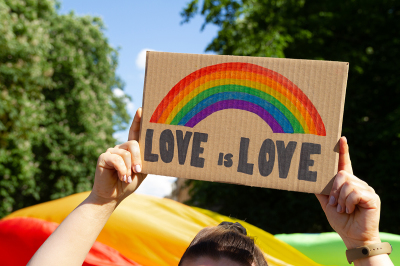How my grandfather destroyed the West

To clarify, he wasn’t exactly my grandfather, and he didn’t exactly destroy the West. Well, not by himself, anyway. I’ll explain.
The man I’m calling my grandfather, for the purposes of this essay, did in fact literally beget my mother. But he had no part in raising her, and she never met him, for which she’s spent her life thanking God. You can read her origin story in a long essay I wrote here, told from the perspective of her birth mother. It could wryly be said that Mom was a child of the sexual revolution, born of an ill-fated dalliance between a free love guru and one of his many groupies. I’ve been asked not to divulge his name, which, despite his best efforts, now lies in the obscurity it so richly deserves. So let’s leave it there and call him “George.”
I’ve been thinking about George a fair bit lately. Not that George or his work are especially worth remembering. But he’s come back to my mind as I look at the progression of what we might call the New Sexual Revolution. Or, if you like, the New New Sexual Revolution. Very roughly, let’s say the revolution of free heterosexual love was Sexual Revolution 1.0, the revolution of free homosexual love was Sexual Revolution 2.0, and now … everything else is Sexual Revolution 3.0. The 3.0 Revolutionaries wave a flag that now updates itself every five seconds, while insisting that they’re just carrying on what the old revolutionaries started.
But some of the 2.0 Revolutionaries loudly beg to differ. Their revolution was based on old-fashioned revolutionary ideas about male bodies, female bodies, and the carnal bliss of pairing your own body with whichever kind you preferred. Now, suddenly, Revolution 3.0 isn’t about loving our bodies at all. In fact, some of the young people under its pink and blue banner are even destroying their ability to orgasm with cross-sex hormones and surgery. And a generation of old-fashioned gays and lesbians all said, “What in the name of all sexual revolutions is this?” Sure, they wanted revolution, but not like that.
Why, you ask, is this all making me think about that good-for-nothing scoundrel I hate to call my grandfather? Well, let me tell you a bit about George.
The first thing you noticed in George’s tiny house were books. Lining every wall, spilling over every shelf, tucked under the desk or wherever else they could be tucked. Rare books, expensive books, dictionaries, lexicons. One grasped right away that this was the library of a scholar. But George wasn’t a normal scholar. George was a scholar of sex.
George took his scholarship seriously. In particular, he made it his very serious business to collect every available scrap of primary resources on erotic folklore, jokes, literature, and “art.” His own book-length study of cunnilingus was the product of, let’s say, meticulous firsthand research. His best-received work, a transgressive essay collection, was admired by everyone from William Carlos Williams to Marshall McLuhan. Decades later, when it had been forgotten, someone in one of his small lecture audiences asked whatever happened to it. Well, he explained with a wink, it was like this: There was this French Arab girl, see, and she fell for him (and his book), then circulated it in her European circles. And then it found its way to Scandinavia, which sparked a boom in pornography, which eventually eroded formal censorship in Europe, which is how we got the American sexual revolution. And now you know the rest of the story.
Or maybe you don’t. George told a lot of stories.
George was sort of an important guy though, a loud and active participant in America’s mid-century censorship wars. He eloquently put his case that if this country was going to become sane, it had to get over itself and its neurotic repression of all things sexual. Let a million flowers bloom, he cried. That is, as long as the flowers were “natural” and not “perverse.” There, George drew a bright line.
George did in fact have a long-running research relationship with the iconic Alfred Kinsey, who became famous for his groundbreaking work on homosexuality. Kinsey drew on extensive field work George had done in New York’s gay scene, including the prostitution scene. But in George’s mind, there was a separation between simply observing gay culture and taking serious steps to normalize it in the broader culture. His partnership with Kinsey soured largely because he came to believe Kinsey was pursuing the latter (and suspected Kinsey himself was more than a little “personally invested” in the whole business). Homosexuals should be tolerated, George supposed, to a point. But to normalize homosexuality was to normalize the “perverse” impulse that threatened to, so to speak, unman George’s sexual revolution. He especially loathed and suspected the “elite gays” insinuating themselves into the highest ranks of publishing, fashion, and other culture-making institutions. If they had their way, he believed they were going to launch a culture-wide subversion of heterosexuality, perhaps even turning straight men into “pseudo-homos.” And he wasn’t alone. His frank private correspondence with Marshall McLuhan shows that McLuhan thought along very similar lines.
You might have thought George would uncritically celebrate all things 60s, but you’d be wrong. He celebrated free love in the sense that he celebrated his male fanboys achieving peak satisfaction with their girlfriends (bullying the girls along if the boys were struggling to persuade them). But he didn’t like the way certain other flowers of the free love revolution were smelling. He was a simple revolutionary. He was a Lady Chatterley’s Lover guy, not a Marquis de Sade guy. He didn’t want violent porn. He just wanted porn. He was disgusted by drugged-out orgies, freaky fashions, tattooed teats. Where was all this weird stuff coming from, and where was it all going? Yes, of course George wanted a sexual revolution, but not like that.
What George didn’t see, or didn’t want to see, was that the line between Revolution 1.0 and Revolution 2.0 was not so very bright, after all. I would submit that something similar is true of the line between 2.0 and 3.0.
Why do I say this? Don’t the old gay rights activists have a point, after all, that body harm is quite literally the opposite of body love, and that trans activists have just invented their own profoundly twisted variation on conversion therapy? And didn’t even George have a point that limitless sex with your girlfriend was one thing, but orgies were another? If I’m going to be an old-fashioned conservative about these things myself, don’t I actually find myself agreeing with old George that gay sex is “perverse,” and that on some level his paranoid fears about “the gaying of everything” actually came true?
The answer is yes, but. Yes, but really, all of these revolutions have a deep commonality. And, paradoxically, it’s that commonality which guarantees they will eat each other alive.
I’ve written before about the old liberal gays’ image of a train that was just pulling nicely into the station before mysteriously derailing, with the “TQ++++” brigade at the wheel. What happened? They really want to know. As a professional crash inspector, I believe I can help. But my sleuthing doesn’t stop with the TQ++++s, nor does it stop with the LGBs. It goes all the way back to George.
Why was George repulsed by gay sex? Because George believed that wasn’t what sex was for. But we ask George, what was sex for? Certainly not for just one man and one woman, and certainly not for life. Divorce, George once wrote, was “another word for hope.” Nobody could accuse him of not leading his revolution by example. From the beginning, that revolution was built on the fundamental axiom that absolute sexual autonomy is every man’s birthright. But much as George would have liked to go on making the rest of the rules from there, George was dismayed to discover that nobody had asked him to make the rules. Because there were no rules anymore. The genie was out. The brakes were off.
“Know ye not,” writes the Apostle Paul to the Corinthians, “that your body is the temple of the Holy Ghost which is in you, which ye have of God, and ye are not your own? For ye are bought with a price.” There’s your braking system. Remove this, uncouple from this, and disaster is not just a possibility. It’s a certainty.
But how? The old revolutionaries still cry. How did we get here? How did body love turn into body hate?
We can’t answer the question until we have interrogated that word “love.” George always swore solemnly that love was everything, that love would save the world. But what was George really talking about when he talked about “love”? What were all those “love” songs really talking about? We approach the answer if we pick another word, a stronger word — not “love,” but “worship.” George worshiped the body, the beauty of the body, the power and the glory. To unite his body with the feminine body of his choice was George’s summum bonum, his highest good.
But what happens when an anxious generation is taught to worship the body, only to decide that their own bodies are not sufficiently worthy objects of worship? What if they look in the mirror and see no beauty that man or woman could desire — at least, in their own minds, whether or not that reflects reality? If only they didn’t have these bodies, they lament. If only they had those bodies instead. Well, why can’t they? It’s a brave new meat Lego world. And their bodies are their own.
I don’t say the old revolutionaries are now wrong to stand in the path of the train crying “Stop!” I don’t believe they are insincere when they urgently plead for the New New Revolution’s victims. I believe Joe Burgo, a gay therapist, is completely sincere when he writes about his grief over damaged young men who struggled with same-sex attraction and were lured by transgenderism into butchering themselves. I share that grief. All decent people should. But what is Joe lamenting when he laments that some of these boys will never be able to go back and “take up the life of a gay man”? Naturally, he laments their lost sex life. What other kind of life would be worth living for a gay man? For any man? Joe struggles to envision it, as did all the revolutionaries before him.
The final answer to Sexual Revolution 3.0 cannot be Sexual Revolution 2.0, or even 1.0. The final answer to new paganism cannot be old paganism. It is not that these answers are too radical. On the contrary, they are not radical enough.
Originally published at Further Up.
Bethel McGrew is a prolific freelance writer, educator, and conservative communicator, with bylines in First Things, National Review, World Opinions, and more. Her Substack, Further Up, is one of the most popular newsletters offering cultural commentary in Christian perspective.




























